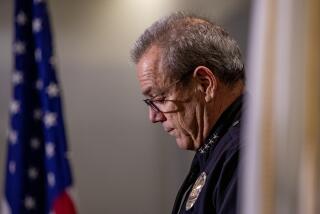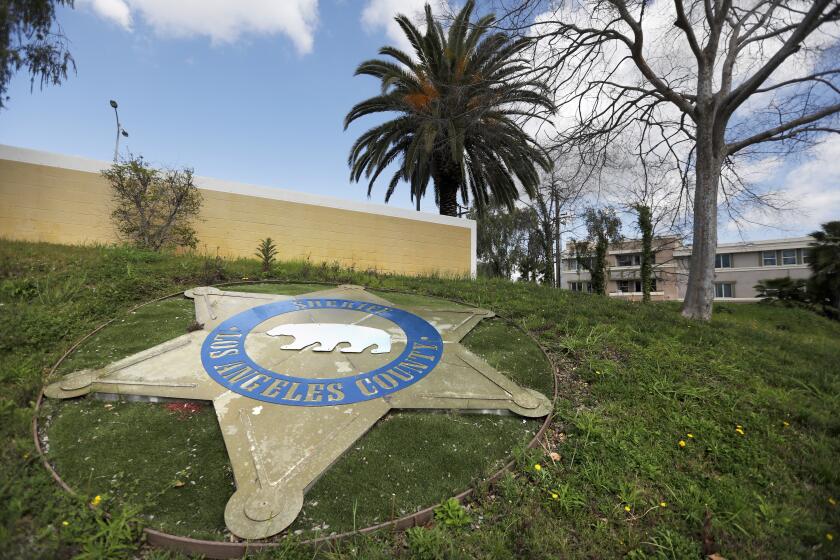Report on fatal shooting of unarmed black man is sharply critical of Pasadena police

Anya Slaughter, left, and Kenneth McDade, parents of Kendrec McDade, are accompanied by attorney Caree Harper as they speak to the media in 2012 after their son’s fatal shooting by Pasadena police.
An independent consultant’s report on the 2012 fatal shooting of an unarmed black man by Pasadena police officers sharply faulted the department’s investigation of the controversial killing, as well as the officers’ tactics.
The redacted document was released Tuesday after a yearlong legal battle during which the police officers union fought to keep its contents private.
Kendrec McDade, 19, was shot seven times after a 911 caller falsely reported that the Azusa High graduate was carrying a gun when he and a friend stole a laptop. The caller eventually pleaded guilty to falsely reporting a criminal offense, and the district attorney’s office cleared Officers Jeff Newlen and Matthew Griffin of wrongdoing in the shooting.
But according to the Office of Independent Review Group, Pasadena police failed during their investigation to determine whether witnesses could corroborate or refute the officers’ claims that McDade had been clutching at his waistband as he fled from their squad car.
The consulting group also faulted the department for not conducting a separate internal affairs investigation into the tactics used by the officers, for waiting 36 hours before interviewing them and for providing the pair with video recordings of the aftermath of the shooting before their interviews — an action that “is likely to distort pure recall either consciously or subconsciously,” the report said.
In addition, the department did not effectively communicate issues and concerns about the March 24, 2012, shooting to the rest of the department so other officers could learn from what occurred, the group concluded.
The report found that the two officers committed numerous tactical blunders that put them in a “precarious position so that once Mr. McDade made an unanticipated move,” deadly force was the only option.
Pasadena activists and an attorney for McDade’s family, who sued along with The Times to have the report made public, said the document showed that the city did not fully cooperate with the consulting group. Skip Hickambottom noted that the Police Department never notified the group when command staff were meeting to conduct an administrative review of the shooting.
“After reading this report, can anyone at the city tell me with a straight face that this was a thorough and transparent investigation?” the attorney asked.
Chief Phillip Sanchez, who was unavailable to comment, has previously said he would implement the report’s recommendations, among which are that the department publicly release reports of independent investigations of shootings.
“We said from the very beginning this report is going to be shared with the public with a few exceptions, and we are comfortable with that,” said department spokeswoman Lt. Tracey Ibarra.
The report released Tuesday includes redactions proposed by the city and approved by Los Angeles County Superior Court Judge James C. Chalfant. An appellate court recently ruled that some of those redactions went too far and were protecting criticism of the Police Department rather than confidential personnel information about the officers. Chalfant has ordered the city to file the report again with fewer redactions by Dec. 1.
Much of the report questioned the actions of the officers during their pursuit of McDade. Griffin maneuvered his patrol car with his left hand while holding his gun in his right. At one point, a tire on the vehicle went flat. Griffin followed McDade through a vehicle access way between buildings, scraping the front fender along one of the walls.
According to the report, Griffin repeatedly told investigators that he had been concerned the path was so narrow that he worried he and his partner would be trapped and unable to exit the vehicle.
“If there was so much concern about the vulnerable position the officers were placed in by traveling through the alley way, then why did he decide to do so?” the report said. “Principles of officer safety instruct that officers should not try to apprehend at all costs and should curtail any pursuit that places them in undue danger.”
The consulting group questioned why investigators never asked the officers why they didn’t turn on the car’s lights and sirens to automatically activate the patrol car’s camera, which might otherwise have recorded the pursuit.
When Newlen exited the car to chase McDade on foot, he did not explain his intentions to his partner, a communication failure that led to an “improvised apprehension,” the report said. Department policy prefers that officers stay together during foot pursuits.
“Officer Newlen left in such a hurry that the passenger door of the police vehicle remained open, requiring Officer Griffin to back up the police vehicle then stop abruptly so that the door would close itself,” the report said. “Since Officer Newlen was no longer in the car, Officer Griffin could not tell his partner that his own plan was to drive the patrol car to cut off the suspect’s escape.”
Later, Griffin made a “potentially disastrous mistake” by exiting his patrol car without putting it in park, the report said.
The report criticizes Griffin’s decision to overtake McDade and stop his car across the fleeing man’s path, positioning himself too close to a suspect he believed was armed. As a result, when McDade ran closer, Griffin believed he had to shoot, the report said.
When Griffin saw McDade running on Sunset Avenue toward the side of his police vehicle, he opened fire. Newlen said he was running after McDade and fired shots when he heard and saw gunfire coming from the direction of the teenager.
Although the consulting group said there were factors discovered after the shooting that point toward McDade’s intention to evade — not confront — the officers, it determined that the evidence showed Griffin feared for his safety when he decided to use deadly force.
Richard Shinee, an attorney for the Pasadena Police Officers’ Assn., said the organization was disappointed that the report was made public and maintained that it contained personnel information about the officers that is confidential by law. He cautioned those reading the report to remember that the officers based their actions on information that McDade was armed. Officers’ actions aren’t made in hindsight, but in real time, he said.
For more Southern California news, follow @lacrimes on Twitter. He can also be reached at richard.winton@latimes.com.
ALSO
El Niño could be the most powerful on record, scientists say
Why the LAFD is still largely white and male despite diversity efforts
Backlash brews against student race protests at Claremont McKenna College
More to Read
Start your day right
Sign up for Essential California for news, features and recommendations from the L.A. Times and beyond in your inbox six days a week.
You may occasionally receive promotional content from the Los Angeles Times.








